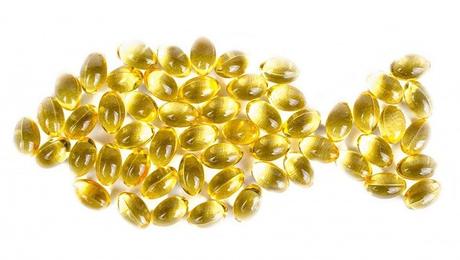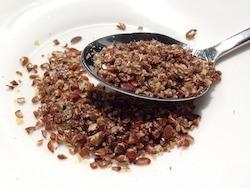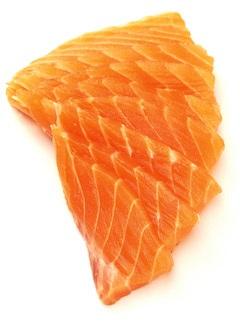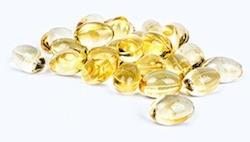
There are 11 kinds of omega-3 fatty acids. These essential fats have been comprehensively studied for their health benefits.
Every year, Americans spend more than $2.5 billion on pills and food that contain omega-3 fatty acids (1).
How do you know if your money is well spent?
Focus on the most important omega-3 fatty acids: EPA, DHA and ALA.
Omega-3 fatty acids can come from animals or plants:
- ALA is mostly found in plants.
- EPA and DHA are mostly found in animal foods like fatty fish.
What Are Omega-3 Fatty Acids?
In the early 1900s, fats were considered to be vital to human health and nutrition. However, little importance was placed on fatty acids as nutrients.
In 1929, it was discovered that fatty acids were necessary for optimal growth (2).
Omega-3 fatty acids are molecules made up of carbon, hydrogen and oxygen. The atoms form a chain along the molecule, with an alpha end and an omega end.
Omega-3 molecules contain a double bond beginning on the third molecule away from the omega end of the chain.
They are polyunsaturated fats. This means that they contain more than one double bond.
With these double bonds, the chain isn’t connected to as many hydrogen atoms as possible, leaving it unsaturated.

In a saturated fat, all of the carbon atoms are saturated with as many hydrogen atoms as possible (3).
Omega-3 fatty acids like omega-6 are classified as essential fatty acids, meaning the body can’t make them. They must be introduced through diet.
Omega-3 fatty acids are important for almost every process in the body, including cardiovascular health, inflammation regulation and cognitive function.
People who don’t get enough omega-3s may have lower cognitive abilities, mood disorders, heart problems, inflammatory diseases and even cancer (4, 5).
KEY POINT: Omega-3 fatty acids are essential for human health, but they must be obtained from the diet.
ALA Is a Common Plant-Based Omega-3 Fatty Acid

ALA, or alpha-linolenic acid, is concentrated in many plant oils.
The chain is comprised of 18 carbon atoms. Like all omega-3s, it has three double bonds (6).
The body cannot use ALA unless it is first converted to DHA or EPA.
Many studies have found that the body is not efficient at converting ALA to DHA (7, 8).
In fact, you might have to consume 25 parts ALA to match the equivalent of the recommended dose of DHA.
Some people’s bodies are better at making this conversion. Conversion of ALA to EPA and DHA is better in women than in men (9).
Although the body is more efficient at converting ALA to EPA than to DHA, it still only converts about 6 percent to EPA (10).
The ALA that remains after conversion is either stored in the body or burned as fuel.
Why is ALA important when the body does not efficiently use it?
Some researchers have linked a plant-rich diet that provides plenty of ALA with a lower risk of death from cardiovascular disease.
Some observational studies have found an association between a diet rich in ALA and a reduced risk of heart disease deaths (11).
Vegetarians may need to make sure that they consume enough ALA to be converted into EPA (12).
On the other hand, some studies have associated ALA with an increased risk of prostate cancer (13). However, findings are inconclusive.
No risk has been found with other omega-3s, and EPA and DHA have been found to protect against prostate cancer (14).
ALA is found in many plants. Some of the highest concentrations occur in the following (15, 16):
- Flax seeds
- Hemp seeds
- Chia seeds
- Purslane
- Soybeans
- Walnuts
- Spinach
- Canola oil
ALA are also found in grass-fed beef (17).
KEY POINT: Alpha-linolenic acid is an omega-3 fatty acid that is found mostly in plants. It is not as bioavailable as EPA or DHA.
EPA Has Several Health Benefits

EPA, or eicosapentaenoic acid, is found mostly in seafood. This omega-3 fatty acid has a chain of 20 carbons and five double bonds.
EPA seems to be more effective than other omega-3 fatty acids, including DHA, in fighting inflammation (18).
While EPA is available in fish oil supplements, eating fatty fish, like salmon, can be even more effective at reducing inflammation.
This may be because the fish contains other beneficial nutrients (19).
Chronic mild inflammation is associated with many diseases (20).
EPA and DHA have been found to reduce inflammation and even the need for steroids in certain conditions, such as inflammatory bowel conditions.
However, findings are inconclusive as to whether it can actually be used to treat or reverse some of these types of diseases (21).
Some studies have found that omega-3 fatty acids can help improve depression symptoms. EPA may be more effective than DHA in treating mood disorders (22).
Women who are deficient in DHA may be more likely to suffer from depression during pregnancy.
However, many researchers have found that supplementing with EPA has been more effective in controlling the depression (23).
These findings are somewhat inconclusive, and more research must be done to prove the correlation (24).
Where does EPA come from? The highest concentrations of EPA are found in cold-water fish, including:
- Herring
- Salmon
- Eel
- Shrimp
- Cod livers
KEY POINT: EPA is an omega-3 fatty acid that can help combat inflammation and improve signs of depression.
Infographic (Pin, Share or Embed)

Share This Infographic On Your Site
<p><a href='https://www.authoritydiet.com/types-omega-3-essential-fatty-acids/'><img src='https://www.authoritydiet.com/images/i/omega-3-types-hd.jpg' border='0' /></a><br /><strong>Please include attribution to AuthorityDiet.com with this graphic.</strong></p>
DHA Is Beneficial For Brain Function, Among Other Things
DHA, or docosahexaenoic acid, may be the omega-3 fatty acid that most people have heard about. It contains 22 carbons and six double bonds.

DHA is a building block of many cells in the body. It is the main fatty acid responsible for forming the central nervous system and retina. DHA is vital for cognitive function (25).
Because most brain growth occurs during infancy and the preschool years, it is crucial that children get enough DHA.
One study demonstrated that mothers who supplemented with DHA and EPA had children with better hand-eye coordination and mental processing abilities at 4 years of age (26).
DHA is one of the main fatty acids in human milk (27).
Many infant formulas are fortified with DHA in order to improve infants’ vision and promote optimal brain development (28).
Infants who don’t get enough DHA early in life may have problems later on.
One study showed that preterm infants who received omega-3 supplements fared better on motor development and verbal comprehension tests around one year (29).
DHA doesn’t only provide the building blocks for brain cells. It is also responsible for protecting cognitive deterioration as you age (30).
As most people get older, the levels of DHA in the brain decrease. This depletion is greater in people with Alzheimer’s disease.
DHA has the potential to support cognitive functions before the onset of Alzheimer’s (31).
You might have heard that DHA is good for your heart health. People with risk factors for cardiovascular disease may already be aware of or take DHA supplements.
DHA can lower levels of triglycerides in the blood. It can also reduce the number of LDL particles (32).
DHA can also make it harder for cancerous cells to survive in the body (33, 34).
Researchers have found that it can help with arthritis, hypertension and type 2 diabetes (35).
Like EPA, DHA is found mainly in seafood. Eggs and chicken also contain DHA (36).
KEY POINT: DHA helps the brain develop and protect brain cells against damage. It has also been found to improve other health conditions, such as inflammatory diseases, cardiovascular disease, type 2 diabetes and some cancers.
Most People Don’t Eat Enough Omega-3 Fatty Acids

The most important essential fatty acids are (37):
- Linoleic acid (LA) (omega-6)
- Arachidonic acid (AA) (omega-6)
- Gamma linolenic acid (GLA) (omega-6)
- Dihomogamma linolenic acid (DGLA) (omega-6)
- Alpha linolenic acid (LNA) (omega-3)
- Eicosapentaenoic acid (EPA) (omega-3)
- Docosahexaenoic acid (DHA) (omega-3)
Most experts say that humans should eat a ratio 1:1 or 2:1 omega-6 fatty acids to omega-3s.
However, most people who eat a western diet consume about 15:1 omega-6s to omega-3s.
This unbalanced ratio is thought to contribute to many diseases, such as cancer, heart disease and autoimmune disease (38).
One reason an unbalanced ratio can cause issues is that enzymes are required For ALA to convert to EPA and DHA. Omega-6 fatty acids compete for the same enzymes (7).
KEY POINT: The typical Western diet usually includes too many omega-6 fatty acids and too few omega-3 fatty acids.
How Much Omega-3 Should You Consume?
Women should consume about 300 mg/d of DHA when they are pregnant or nursing.

Most adults should take in at least 220 mg of DHA, 220 mg of EHA and 1,100 to 2,220 mg of ALA per day (39, 40).
These numbers are based on a 2,000-calorie diet. People who consume more or fewer calories will have to adjust their optimal omega-3 intakes.
You can also get your omega-3s from fish.
Below, we have listed the amounts of DHA and EPA in 100 g of different types of raw fish (41):
- Wild Atlantic salmon: 320 mg EPA, 1,110 mg DHA
- Farmed Atlantic salmon: 860 mg EPA, 1,100 mg DHA
- Blue fish: 250 mg EPA, 520 mg DHA
- Atlantic cod: 60 mg EPA, 120 mg DHA
- Pacific cod: 80 mg EPA, 140 mg DHA
- Atlantic mackerel: 900 mg EPA, 1,400 mg DHA
KEY POINT: The recommended adequate intake for most adults is 220 mg of DHA, 220 mg of EHA and 1,100 to 2,220 mg of ALA per day. Those numbers should be adjusted if you eat fewer than or more than 2,000 calories, are pregnant or nursing or are treating a specific condition.
Are There Other Omega-3 Fatty Acids?

ALA, EPA and DHA are the most common omega-3 fatty acids found in the diet.
There are several other omega-3 fatty acids in the foods that you may eat (42):
- Hexadecatrienoic acid (HTA)
- Stearidonic acid (SDA)
- Eicosatrienoic acid (ETE)
- Eicosatetraenoic acid (ETA)
- Heneicosapentaenoic acid (HPA)
- Docosapentaenoic acid (DPA)
- Tetracosapentaenoic acid
- Tetracosahexaenoic acid (Nicinic acid)
KEY POINT: Other omega-3 fatty acids are found in some foods.
Which Omega-3 Is Preferred?
Experts consider EPA and DHA to be the preferred sources of omega-3 fatty acids.
Depending on your needs you may want:
- More EPA (like this supplement) for dealing with inflammation and depression.
- More DHA (like this supplement) for dealing with cardiovascular health and optimal cognitive health.
However, people who don’t eat eggs, meat or seafood may have trouble incorporating these fatty acids into their diets.
Vegetarians and vegans may avoid supplements that are derived from animals.
It’s important for people who don’t consume animal products to take in enough ALA to convert to EPA and DHA.
Vegetarians can optimize the conversion by reducing their intake of omega-6 fatty acids in relation to omega-3s.
They can also take a vegetarian supplement made from sea plants such as microalgae (44).
For most healthy people, the conversion of ALA to EPA and DHA is sufficient to maintain wellness.
However eating a diet that’s high in EPA and DHA or taking a supplement that directly provides those omega-3s is ideal.
What do you think of omega-3 fatty acids? Share your thoughts in the comments below.

